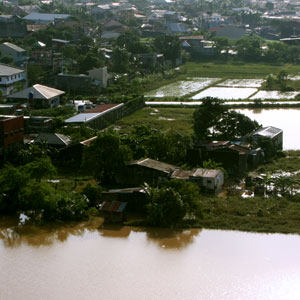“It was total darkness—no man’s land,” Cainta Mayor Mon Ilagan describes how night fell on the day Ondoy struck on September 27, 2009. He was stalled on Imelda Avenue on the garbage truck the city hall sent to him early that day, along with his youngest child, wife Veron, and some 100 stranded commuters they picked up along the way. “The current was too rough.” the Mayor continues, “And the water too high that we decided we couldn’t proceed anymore. We stayed inside the truck for about nine hours from 10:30 AM to midnight, without food or water.”
The night before, Ilagan says he’d been monitoring the situation because the rains were nonstop. As soon as day broke and as soon as the garbage truck he requested as transportation came, he and his family ventured out. The flood was already waist-deep, he says. Where were the rescue teams? What happened to the local disaster coordinating council? The Mayor explains, “Unfortunately, all the members of the Municipal Disaster Coordinating Council (MDCC) were trapped by the rising waters, too. They failed to show up so wala talaga, no operations at all. Communication lines bogged down already, but my phone was still working. Then at about 1PM, I went on-air via phone patch at ANC, DZRH, and some other media, calling Meralco to shut down the power kasi it might cause electrocution. Fortunately, Manolo Lopez was tuned in and he ordered that the power be shut down.”
Wait & See
Cainta, Rizal suffered a major destruction in the hands of Typhoon Ondoy last year. As 95% of its land area was submerged in 7 to 8 feet of water, 45,000 families were affected, especially those staying in both East and West Manggahan floodways. Damages to the infrastructures (roads, bridges, schools, buildings and others) amounted to more than 100 million; rehabilitation and re-engineering cost thrice as much. A total of 15 people died due to drowning.
In total darkness, all Mayor Ilagan and his men could do was just to wait for the waters to subside. At about 6 a.m. the next day, it finally did. Ordering his men to gather ropes, they stepped down from the vehicle and rushed towards city hall. Immediately, he convened the MDCC. Food was distributed to the affected families; rubber boats and life vests were sent out to the barangays. He also went on-air again, and asked for help from the government, the media and his friends. The response was quite impressive; President Noynoy Aquino and former President Erap Estrada, Senators Manny Villar and Mar Roxas, host Boy Abunda, and actress Kris Aquino, and several government officials dropped by. Clearly, the Mayor’s broadcast journalist days served him well.
While Mayor Ilagan appreciated the overwhelming and much needed support from the media, he did, however, consider the criticisms that would (and did) come over how he handled the situation. All eyes were on him as the head of the city. “I was really nervous, because if I fail to handle the Ondoy problem, then I won’t have another chance in the next elections because people would grade my performance. Titingnan nila kung failure ba ito.”
After The Rains
It took a month before the floods actually cleared. With the support of Rizal Governor Jun Ynares, assessment began, and work took over the re-elected Mayor’s anxiety over his performance as a public servant. “There were some areas na after three weeks, mataas pa din ang water. Dahil hindi madaanan ang kalye nila, we bought coconut lumber, at ginawa naming itong tulay, para lang iyong mga bata at papasok sa opisina ay hindi na lulusob sa baha. I think we bought around P100,000 worth of coconut lumber. And I brought trucks din para sipsipin iyong mga stagnant water.”
While clearing operations and life post Ondoy went about, the city also set about its official function. The local government launched “Save the Cainta River Movement” to prevent the continuing deterioration of the river. More than a hundred families were awarded with 40 square meter lots in San Jose, Antipolo City, including their means of livelihood, and other needs. Scheduled to be moved are 400 families to Baras, Antipolo City. An P18-million project for the interceptor (waterway) of Barangay San Andres was also approved. Construction is still ongoing. A damaged 300-meter linear riprap along Brookside and Saint Francis subdivision is also being built and repaired. A 70-man team was formed to clean the waterways, Cainta River, and others daily with the help of two backload trucks.
To supplement all these efforts, Mayor Ilagan organized a risk reduction seminar, sponsored by Oxford Committee for Famine Relief (OXFAM), an international confederation of different groups around the world that helps the local government and civic organizations in giving out lectures on disaster risk management plan. While he believes the local government lacked the preparation for a disaster of Ondoy’s magnitude, Mayor Ilagan, who firmly believes that protection for the environment is part of the solution, says, “We also need to re-educate our people. They keep on complaining about the garbage and the flood. Without realizing it, they just throw their trash anywhere. That’s a problem that we have discovered.”
In close coordination with the MDCC and the Barangay Disaster Coordinating Council, and all the people from the subdivisions who attend a seminar on disaster risk management system, Mayor Ilagan intends for Cainta to be fully prepared this time for any big typhoons and possible earthquakes. “It is really important for us to understand the municipal disaster risk management plan program,” he says. “This will lead to the concern for the environment, to saving lives, and to doing something good for our community and our country.”






